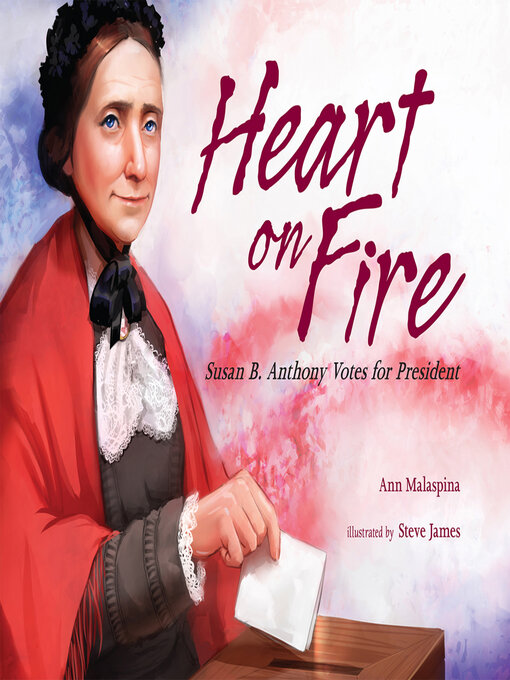Top 10 on the 2013 Amelia Bloomer list
A nonfiction story about suffragist Susan B. Anthony's first trip to the ballot box.
On November 5, 1872, Susan B. Anthony made history—and broke the law—when she voted in the US presidential election, a privilege that had been reserved for men. She was arrested, tried, and found guilty: "The greatest outrage History every witnessed," she wrote in her journal. It wasn't until 1920 that women were granted the right to vote, but the civil rights victory would not have been possible without Susan B. Anthony's leadership and passion to stand up for what was right.
-
Creators
-
Publisher
-
Release date
July 1, 2012 -
Formats
-
OverDrive Read
- ISBN: 9780807531891
-
PDF ebook
- ISBN: 9780807531891
- File size: 69801 KB
-
-
Languages
- English
-
Levels
- ATOS Level: 4.7
- Lexile® Measure: 690
- Interest Level: K-3(LG)
- Text Difficulty: 3
-
Reviews
-
School Library Journal
August 1, 2012
Gr 2-4-Concentrating on one incident from her subject's life, Malaspina describes how Anthony voted in the 1872 presidential election, then was arrested, tried, found guilty, and fined. She and her lawyer took the position that the 14th amendment, ratified in 1868, extended voting rights to women. The judge did not agree. The case, however, helped bring attention to the suffragist movement. Although women did not gain the right to vote until 1920, this book demonstrates how Anthony, Elizabeth Cady Stanton, and other early activists were tireless in their efforts. Period photographs of Anthony often present a stern demeanor, but James takes a somewhat different approach. His digital-media paintings depict an energetic, intense figure with pleasant features. Bold splashes of color add vividness to the pages. At one point, the author compares Anthony to Rosa Parks, another woman who challenged a law she viewed as unjust. Although not directly sourced, quotations appear to come from Anthony's writings and historical accounts of her trial. As another presidential election approaches, this title would be a good addition to voting or women's-history units.-Lucinda Snyder Whitehurst, St. Christopher's School, Richmond, VA
Copyright 2012 School Library Journal, LLC Used with permission.
-
Kirkus
August 1, 2012
In spare and elegant free verse, Malaspina shares a vivid act of civil disobedience. Susan B. Anthony registered to vote in Rochester, N.Y., on November 1, 1872. She and 15 other women cast their ballots four days later, hoping that the new 14th Amendment, which stated that "All persons born or naturalized in the United States...are citizens of the United States," would permit all women the right to vote. Instead, she was arrested and brought to trial, found guilty because women were not permitted the vote, and fined $100, which she never paid. James fills the pages with strongly modeled images and many close-ups of Susan's face and the faces of judge, jury, police officers and followers. He makes their faces mobile and intense, so children can feel the force of these ideas as well as hear the words. The refrain, set in larger and alternate type, is "Outrageous. / Unbelievable. / True," carrying the emotion and idea forward in an accessible and powerful way. The book opens with the text of the 14th and 19th Amendments and closes with facsimiles of a newspaper cartoon, a photograph and Susan B. Anthony's letter to her close friend Elizabeth Cady Stanton: "Well I have been & gone & done it!!--positively voted...." Inspiring fodder for an electoral--or any other--year. (afterword, bibliography) (Picture book/nonfiction. 5-9)COPYRIGHT(2012) Kirkus Reviews, ALL RIGHTS RESERVED.
-
Booklist
September 15, 2012
Grades 2-4 A multitude of books have been written about Susan B. Anthony, and here, another picture book joins the ranks. The subtitle indicates the focus, which is on a single significant event in her life rather than a biographical overview. The sparse text, arranged much like prose poetry, begins by setting the time and place: Rochester, New York, November 1, 1872, days before Susan voted, and was arrested and put on trial. Her crime was voting when women were not allowed to do so. The narrative ends with the judge's infamously unfair decision of guilty, whereupon Susan was fined $100. Embellished dialogue and descriptions lend an immediacy to the story, although there are occasional missing pieces (for instance, no explanation for why the trial was held in Canandaigua, New York, and not Rochester, where Susan lived). James' softly drawn paintings focus on faces, which are well characterized and realistic, while other details are intentionally less defined. A strong, straightforward introduction to an activist kids that will return to as they grow older.(Reprinted with permission of Booklist, copyright 2012, American Library Association.) -
The Horn Book
January 1, 2013
Susan B. Anthony's fight for women's suffrage is documented in accessible free verse that focuses on her November 1872 arrest for voting and her 1873 trial. At times the realistic illustrations (mostly portraits) verge on caricature. Text of the Fourteenth and Nineteenth Amendments introduce the story. An author's note and archival reproductions provide more information. Bib.(Copyright 2013 by The Horn Book, Incorporated, Boston. All rights reserved.)
-
Formats
- OverDrive Read
- PDF ebook
Languages
- English
Levels
- ATOS Level:4.7
- Lexile® Measure:690
- Interest Level:K-3(LG)
- Text Difficulty:3
Loading
Why is availability limited?
×Availability can change throughout the month based on the library's budget. You can still place a hold on the title, and your hold will be automatically filled as soon as the title is available again.
The Kindle Book format for this title is not supported on:
×Read-along ebook
×The OverDrive Read format of this ebook has professional narration that plays while you read in your browser. Learn more here.




